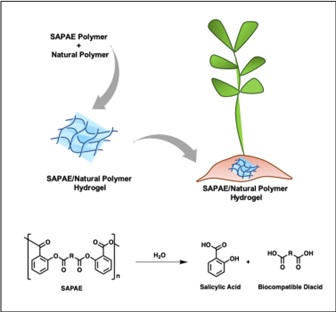Novel Hydrogel for Crop Drought Management
Tech ID: 33118 / UC Case 2022-891-0
Background
Crops have natural, adaptive responses to survive abiotic stress conditions like drought. However, these responses are not sufficient to secure food production given the increasing threats of climate change. There are significant efforts in developing new technologies to enhance crop response to abiotic stresses but some will take years to reach the market due to the governmental regulatory processes.
Natural polymers such as cellulose, starch, and glycogen have gained attention in the crop protection area due to their biocompatibility, biodegradability, and water solubility. In the presence of cross-linking agents, those polymers form hydrogels, which are three-dimensional networks that absorb and retain large amounts of water.
Brief Description
The Uhrich lab at the University of California, Riverside has developed a novel hydrogel, called salicylic acid-based poly(anhydride ester) or SAPAE, for agricultural applications. This hydrogel is comprised of bioactive, biocompatible polymers derived from salicylic acid that biodegrade into salicylic acid, which is a natural plant growth hormone. The hydrogel can cross-link itself or in combination with natural polymers forming three-dimensional networks capable of absorbing fertilizer, pesticides, and large amounts of water. In addition to enhancing plant growth, salicylic acid alleviates drought stress. The UCR hydrogel may be applied to soil so it not only releases salicylic acid but also water to counter drought.

Fig 1: Illustration of SAPAE-based hydrogels that biodegrade into salicylic acid and also release encapsulated fertilizers and pesticides.
Application
- A hydrogel for controlled release of water, salicylic acid, fertilizers, and pesticides against drought stress.
Patent Status
Patent Pending
Contact
- Grace Yee
- grace.yee@ucr.edu
- tel: View Phone Number.
Other Information
Keywords
Natural-based hydrogel, salicylic acid, poly(anhydride ester), controlled release, drought stress, fertilizer, pesticides
